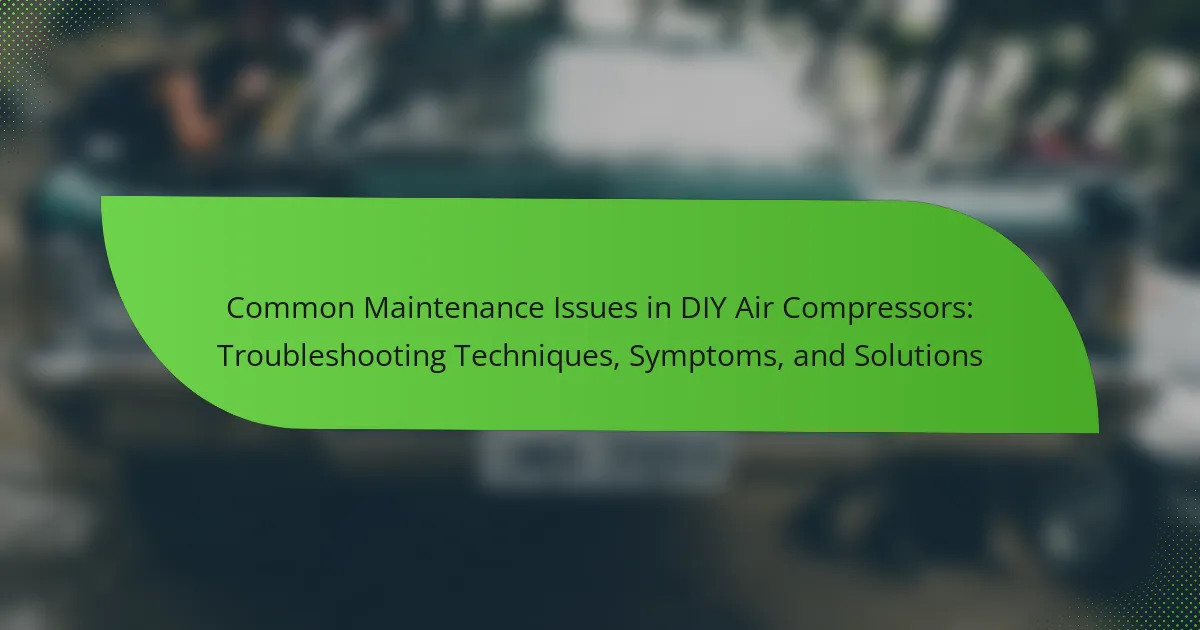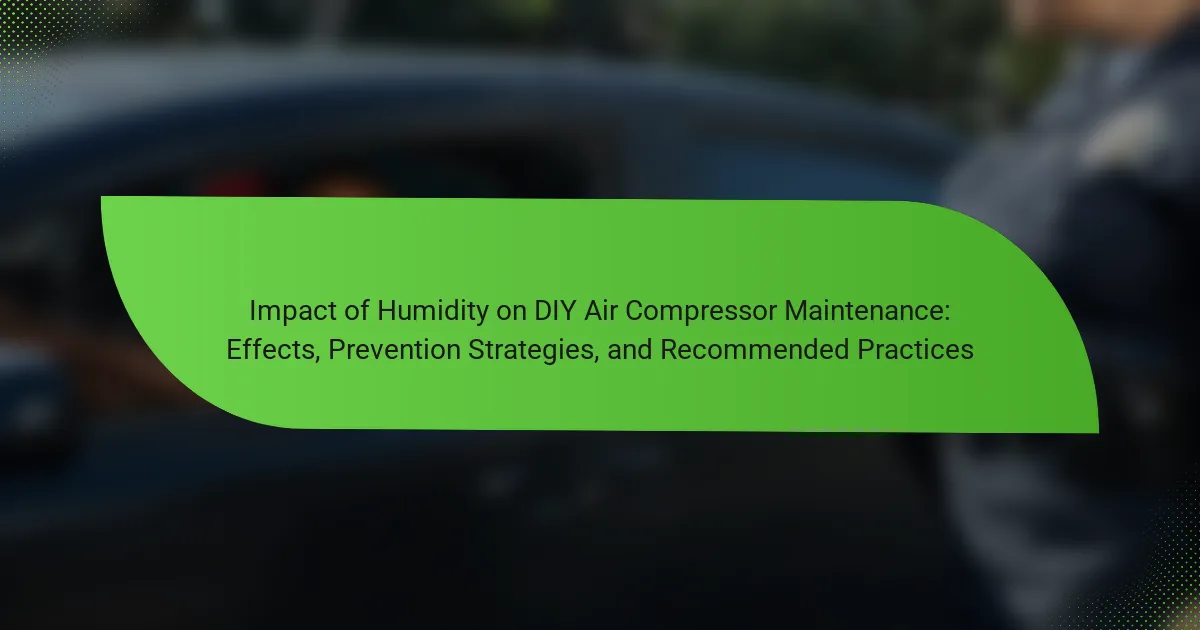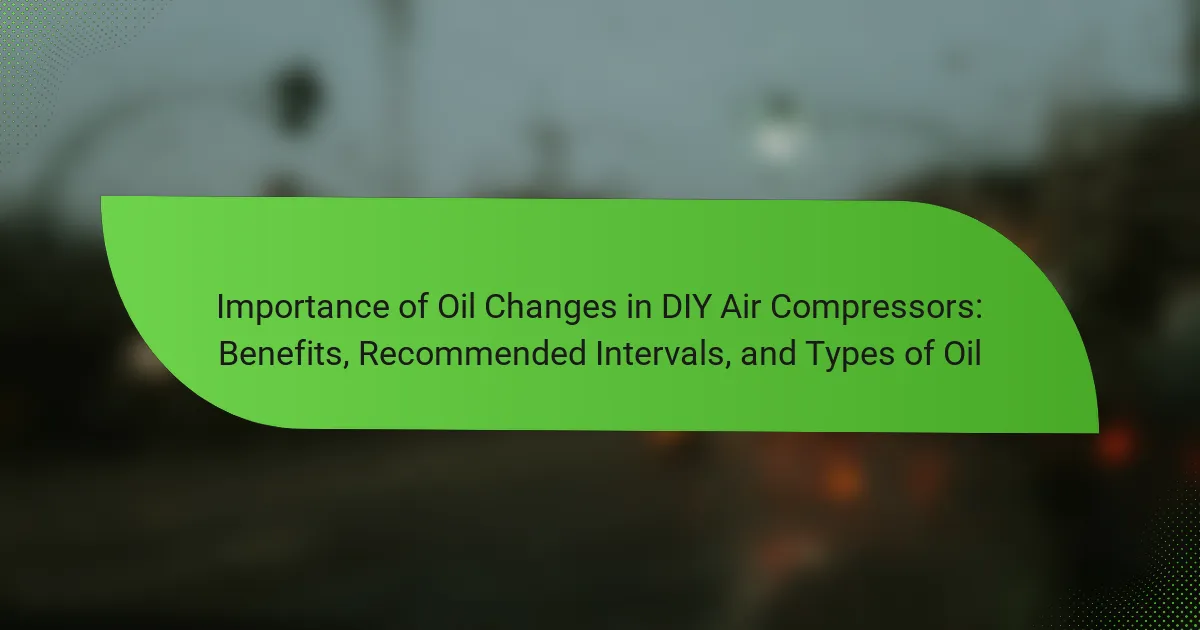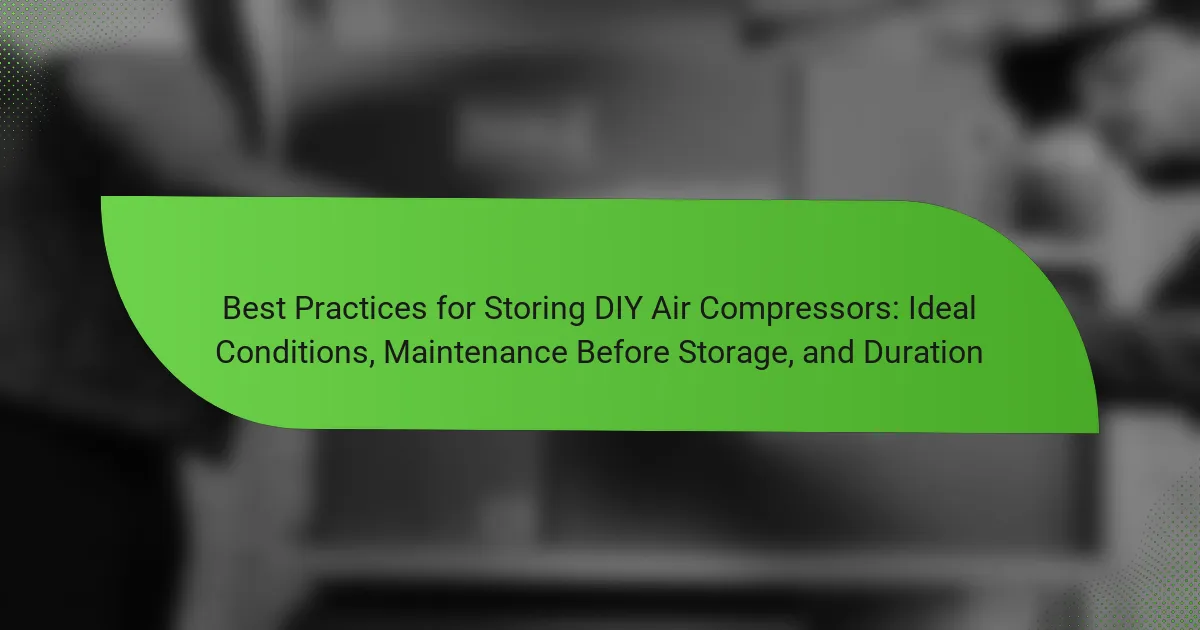Hoses are essential components in DIY air compressor maintenance, responsible for transporting compressed air to various tools and accessories. This article outlines the importance of maintaining hoses to ensure efficient air delivery and prevent operational issues caused by air leaks. Key topics include signs that indicate when hoses need replacement, such as visible cracks, air leakage, and decreased airflow, as well as the recommended maintenance frequency of every three to six months. Regular inspection and timely replacement of hoses are crucial for enhancing safety and extending their lifespan, ultimately ensuring optimal compressor performance.
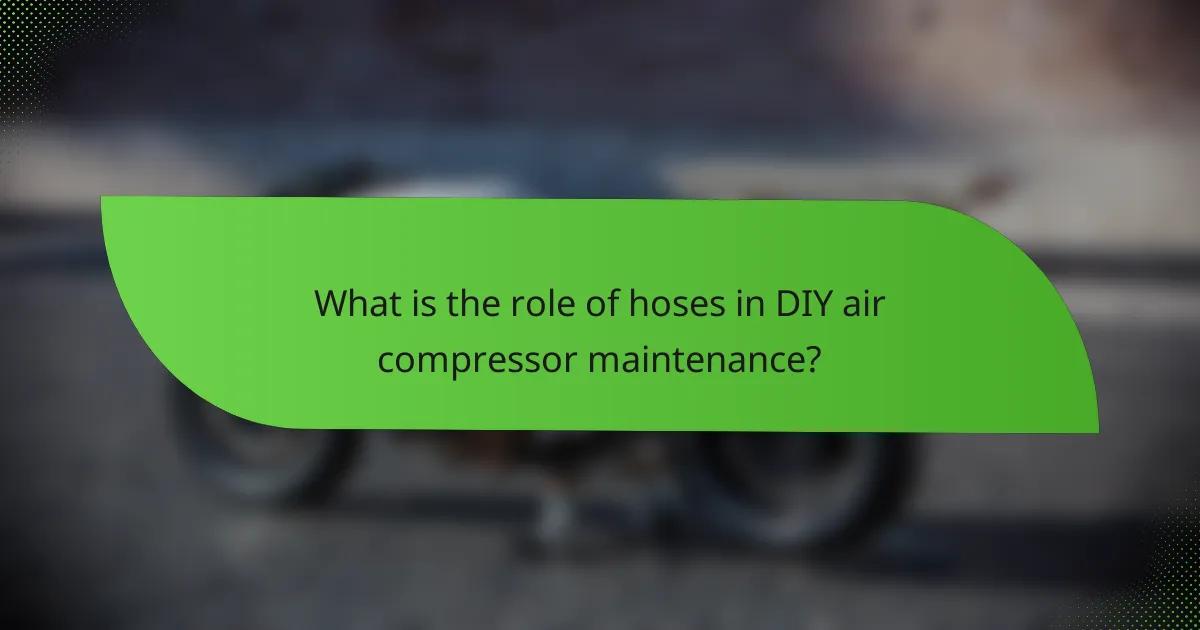
What is the role of hoses in DIY air compressor maintenance?
Hoses play a critical role in DIY air compressor maintenance. They transport compressed air from the compressor to tools and accessories. Properly functioning hoses ensure efficient air delivery. Damaged or worn hoses can lead to air leaks. Air leaks reduce the compressor’s efficiency and increase energy consumption. Regular inspection of hoses is essential for identifying wear and tear. Signs of deterioration include cracks, bulges, or fraying. Timely replacement of hoses prevents operational issues and enhances safety.
How do hoses contribute to the overall function of an air compressor?
Hoses are essential components of an air compressor as they transport compressed air from the compressor to various tools and applications. They maintain the pressure of the air while minimizing leaks and losses during transfer. Properly functioning hoses ensure that the air compressor operates efficiently and effectively. Damaged or worn hoses can lead to decreased performance and increased energy consumption. Quality hoses are designed to withstand high pressure and temperature, which are typical in air compressor applications. Regular inspection of hoses is necessary to identify wear and tear, ensuring optimal performance of the air compressor system.
What types of hoses are commonly used in air compressors?
Rubber hoses, PVC hoses, and polyurethane hoses are commonly used in air compressors. Rubber hoses are durable and flexible, making them suitable for high-pressure applications. PVC hoses are lightweight and resistant to abrasion, ideal for general use. Polyurethane hoses are known for their flexibility and [censured] resistance, often used in portable air compressor setups. Each type serves specific functions based on pressure ratings and environmental conditions.
What are the key attributes of hoses that affect air compressor performance?
The key attributes of hoses that affect air compressor performance include diameter, length, material, and pressure rating. Hose diameter impacts airflow and pressure. A larger diameter allows more air to pass, enhancing performance. Hose length influences pressure drop; longer hoses can reduce efficiency. The material affects flexibility and durability. Rubber hoses are more flexible, while PVC hoses are lighter but less durable. Pressure rating indicates the maximum pressure a hose can handle safely. Using a hose with an inadequate pressure rating can lead to failure. These attributes collectively determine the efficiency and safety of the air compressor system.
Why is regular inspection of hoses important for air compressor maintenance?
Regular inspection of hoses is crucial for air compressor maintenance to ensure optimal performance and safety. Hoses are responsible for transporting air from the compressor to various tools and appliances. Over time, hoses can develop wear, cracks, or leaks. Such damage can lead to air loss, reducing efficiency and increasing energy costs. Additionally, compromised hoses can pose safety hazards, including potential bursts during operation. Regular inspections help identify these issues early, allowing for timely replacements or repairs. According to industry standards, inspecting hoses every few months can prevent costly breakdowns and enhance the lifespan of the air compressor system.
What specific aspects should be inspected during hose checks?
Inspecting hoses involves checking for wear, leaks, and proper connections. Look for cracks or abrasions on the surface. Inspect the fittings for corrosion or damage. Ensure that the hose is securely attached to the compressor and tools. Check for kinks or twists that may restrict airflow. Verify the hose’s pressure rating matches the compressor’s output. Regular inspections prevent failures during operation. These checks are critical for safe and efficient air compressor performance.
How often should hoses be inspected for optimal performance?
Hoses should be inspected at least once every three months for optimal performance. Regular inspections help identify wear, cracks, or leaks. Frequent checks ensure hoses function properly and maintain air pressure. Additionally, if hoses are used extensively, more frequent inspections are recommended. For instance, daily or weekly checks may be necessary in high-use environments. This proactive approach minimizes potential failures and extends hose lifespan. Regular maintenance is crucial for safety and efficiency in air compressor operations.
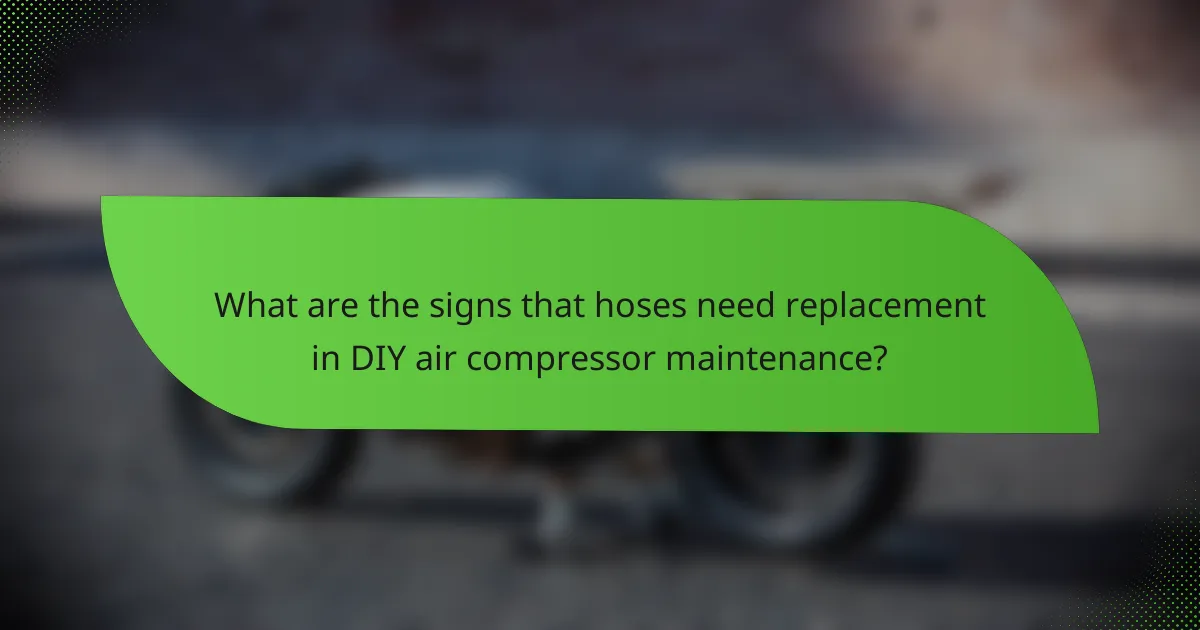
What are the signs that hoses need replacement in DIY air compressor maintenance?
Signs that hoses need replacement in DIY air compressor maintenance include visible cracks or splits. These damages compromise the hose’s integrity. Additionally, if there is air leakage, it indicates that the hose is failing. A decrease in airflow can also suggest that the hose is clogged or damaged. Furthermore, hoses that are excessively worn or frayed should be replaced to ensure safety and efficiency. Lastly, if the hose is stiff or brittle, it is likely past its useful life and should be changed. Regular inspection is crucial to identify these signs early.
What physical signs indicate a hose may be failing?
Cracks or splits in the hose material indicate potential failure. These visible damages compromise the hose’s integrity. Bulging areas suggest internal pressure issues. This deformation can lead to bursts under stress. Leaks or wet spots on the hose surface are clear signs of deterioration. Such leaks can cause loss of pressure and efficiency. Discoloration or fading of the hose can indicate material degradation. This often results from prolonged exposure to elements. Lastly, excessive stiffness or brittleness can signal aging. These physical signs collectively suggest that the hose may be failing and should be inspected or replaced.
How can wear and tear on hoses affect air compressor efficiency?
Wear and tear on hoses can significantly reduce air compressor efficiency. Damaged hoses may develop leaks, causing a drop in air pressure. This results in the compressor working harder to maintain pressure levels. Increased strain on the compressor can lead to higher energy consumption. Additionally, worn hoses may restrict airflow, further decreasing efficiency. According to the U.S. Department of Energy, leaks in compressed air systems can waste 20-30% of energy. Regular inspection and timely replacement of hoses can prevent these issues and maintain optimal performance.
What are the consequences of ignoring hose replacement signs?
Ignoring hose replacement signs can lead to serious consequences. Deteriorating hoses may burst, causing air leaks. This can reduce the efficiency of air compressors. A compromised hose can also result in equipment damage. Equipment failure may incur costly repairs. Additionally, leaks can create safety hazards. For instance, pressurized air can cause injuries. Regular hose inspection and timely replacement are crucial for optimal performance.
How do environmental factors influence hose durability and replacement needs?
Environmental factors significantly influence hose durability and replacement needs. Exposure to extreme temperatures can degrade hose materials. High heat can cause hoses to become brittle, while extreme cold may make them less flexible. UV radiation from sunlight can lead to material breakdown, particularly in rubber hoses. Additionally, chemical exposure, such as oils or solvents, can weaken hoses and shorten their lifespan. Humidity can promote mold growth, which may further deteriorate hoses. Regular inspections in varying environmental conditions are essential for identifying wear and tear. Thus, understanding these factors aids in timely replacements and maintenance.
What role do temperature and humidity play in hose wear?
Temperature and humidity significantly affect hose wear. High temperatures can cause hoses to become brittle and crack. Conversely, low temperatures may lead to hose flexibility issues. Humidity introduces moisture that can promote mold and corrosion. These factors decrease the lifespan of hoses. For instance, hoses exposed to extreme temperatures can wear out 50% faster than those in moderate conditions. Regular inspection is essential to identify wear caused by these environmental factors.
How can proper storage extend the life of air compressor hoses?
Proper storage extends the life of air compressor hoses by preventing damage and degradation. Storing hoses in a cool, dry place avoids exposure to extreme temperatures and moisture. This reduces the risk of cracks and leaks. Additionally, coiling hoses loosely prevents kinking and bending. Using hose reels or hangers keeps them organized and off the ground. Such practices minimize wear and tear from friction and environmental factors. Regularly inspecting stored hoses for any signs of wear also promotes longevity. Overall, proper storage practices significantly enhance the durability of air compressor hoses.
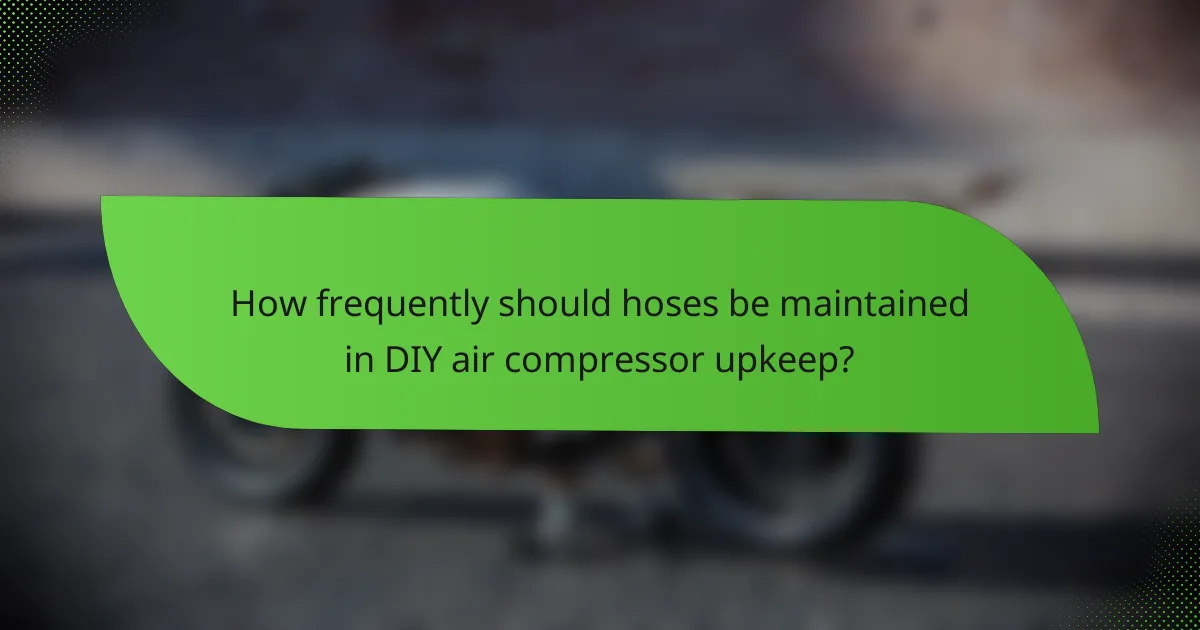
How frequently should hoses be maintained in DIY air compressor upkeep?
Hoses in DIY air compressor upkeep should be maintained every three to six months. Regular inspection helps identify wear and tear. This frequency ensures optimal performance and safety. Hoses that are cracked or frayed should be replaced immediately. Additionally, checking for leaks during maintenance is crucial. Proper maintenance extends the lifespan of the hoses. It also prevents air loss, which can affect compressor efficiency. Following this schedule keeps your air compressor functioning effectively.
What maintenance practices are recommended for hoses?
Regular inspection and cleaning are essential maintenance practices for hoses. Inspect hoses for signs of wear, cracks, or leaks. Cleaning hoses helps remove debris and prevents clogs. Store hoses properly to avoid kinks and damage. Use hose reels or hangers for better organization. Avoid exposing hoses to extreme temperatures and chemicals. Replace hoses that show significant wear or damage. Following these practices can extend the lifespan of hoses and ensure efficient operation.
How can regular cleaning and care improve hose lifespan?
Regular cleaning and care can significantly improve a hose’s lifespan. Cleaning removes debris and contaminants that can cause wear and tear. This prevents blockages that may lead to increased pressure and hose damage. Regular inspections allow for early detection of cracks or leaks. Addressing these issues promptly can prevent further deterioration. Proper storage also protects hoses from UV rays and extreme temperatures. Hoses that are well-maintained can last up to 50% longer than neglected ones. Consistent care ensures optimal performance and reliability during use.
What tools and materials are needed for hose maintenance?
Essential tools and materials for hose maintenance include a hose clamp, a wrench, and a hose cutter. A hose clamp secures hoses to fittings, preventing leaks. A wrench is needed to tighten or loosen fittings during maintenance. A hose cutter allows for precise trimming of hoses. Additionally, rubber grommets can help seal connections. A hose cleaning brush is useful for removing debris from inside the hose. Finally, thread seal tape can ensure airtight connections. These tools and materials are crucial for effective hose maintenance and ensuring optimal performance.
What are the best practices for ensuring hose longevity in air compressors?
Regular inspection and maintenance are essential for ensuring hose longevity in air compressors. Inspect hoses for signs of wear, such as cracks or abrasions, at least once a month. Keep hoses clean and free from debris to prevent blockages. Avoid sharp bends and kinks in hoses during use, as these can cause damage over time. Use the correct fittings and ensure they are securely attached to prevent leaks. Store hoses properly when not in use, avoiding exposure to extreme temperatures or sunlight. Replace hoses that show significant wear or damage immediately. Following these practices can extend the lifespan of air compressor hoses significantly.
How can users identify and resolve common hose-related issues?
Users can identify common hose-related issues by inspecting for leaks, cracks, or wear. A visible leak often indicates a damaged hose. Cracks or bulges in the hose surface suggest it’s time for replacement. Users should also check for kinks that restrict airflow. Kinks can lead to pressure drops and inefficiency.
To resolve these issues, users should first tighten any loose connections. If leaks persist, replace the damaged section of the hose. For cracks, cutting out the damaged part and using a hose connector can restore functionality. Regular inspections every few months can prevent future problems.
Maintaining hoses properly enhances the efficiency of air compressors. Proper maintenance includes checking for signs of wear and replacing hoses as needed.
What tips should DIYers follow to maintain their air compressor hoses effectively?
DIYers should follow several tips to maintain their air compressor hoses effectively. Regularly inspect hoses for signs of wear, such as cracks or fraying. Replace any damaged hoses immediately to prevent air leaks. Keep hoses clean and free from debris to ensure optimal performance. Store hoses properly by coiling them without kinks or twists. Avoid exposing hoses to extreme temperatures or direct sunlight, as this can degrade materials. Use appropriate fittings and connectors to prevent leaks at attachment points. Periodically check for air pressure consistency to identify potential issues early. Following these practices can extend the lifespan of air compressor hoses and maintain efficiency.
The main entity of this article is hoses, specifically their role in DIY air compressor maintenance. The article covers the importance of hoses in transporting compressed air, the types of hoses commonly used, and key attributes affecting performance, such as diameter and pressure rating. It emphasizes the necessity of regular inspections to identify wear and tear, signs that indicate when hoses should be replaced, and the impact of environmental factors on hose durability. Additionally, the article provides maintenance practices and tools needed for effective upkeep, ensuring optimal efficiency and safety in air compressor operations.
